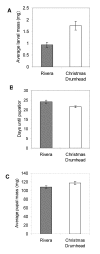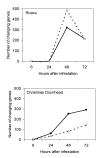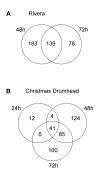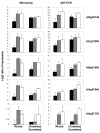Genotypic variation in genome-wide transcription profiles induced by insect feeding: Brassica oleracea--Pieris rapae interactions
- PMID: 17640338
- PMCID: PMC1940009
- DOI: 10.1186/1471-2164-8-239
Genotypic variation in genome-wide transcription profiles induced by insect feeding: Brassica oleracea--Pieris rapae interactions
Abstract
Background: Transcriptional profiling after herbivore attack reveals, at the molecular level, how plants respond to this type of biotic stress. Comparing herbivore-induced transcriptional responses of plants with different phenotypes provides insight into plant defense mechanisms. Here, we compare the global gene expression patterns induced by Pieris rapae caterpillar attack in two white cabbage (Brassica oleracea var. capitata) cultivars. The two cultivars are shown to differ in their level of direct defense against caterpillar feeding. Because Brassica full genome microarrays are not yet available, 70-mer oligonucleotide microarrays based on the Arabidopsis thaliana genome were used for this non-model plant.
Results: The transcriptional responses of the two cultivars differed in timing as characterized by changes in their expression pattern after 24, 48 and 72 hours of caterpillar feeding. In addition, they also differed qualitatively. Surprisingly, of all genes induced at any time point, only one third was induced in both cultivars. Analyses of transcriptional responses after jasmonate treatment revealed that the difference in timing did not hold for the response to this phytohormone. Additionally, comparisons between Pieris rapae- and jasmonate-induced transcriptional responses showed that Pieris rapae induced more jasmonate-independent than jasmonate-dependent genes.
Conclusion: The present study clearly shows that global transcriptional responses in two cultivars of the same plant species in response to insect feeding can differ dramatically. Several of these differences involve genes that are known to have an impact on Pieris rapae performance and probably underlie different mechanisms of direct defense, present in the cultivars.
Figures






Similar articles
-
A conserved transcript pattern in response to a specialist and a generalist herbivore.Plant Cell. 2004 Nov;16(11):3132-47. doi: 10.1105/tpc.104.026120. Epub 2004 Oct 19. Plant Cell. 2004. PMID: 15494554 Free PMC article.
-
Will chemical defenses become more effective against specialist herbivores under elevated CO2?Glob Chang Biol. 2014 Oct;20(10):3159-76. doi: 10.1111/gcb.12633. Epub 2014 Jun 21. Glob Chang Biol. 2014. PMID: 24832554
-
Sensitivity and speed of induced defense of cabbage (Brassica oleracea L.): dynamics of BoLOX expression patterns during insect and pathogen attack.Mol Plant Microbe Interact. 2007 Nov;20(11):1332-45. doi: 10.1094/MPMI-20-11-1332. Mol Plant Microbe Interact. 2007. PMID: 17977145
-
Monitoring genome-wide expression in plants.Curr Opin Biotechnol. 2000 Apr;11(2):162-7. doi: 10.1016/s0958-1669(00)00084-7. Curr Opin Biotechnol. 2000. PMID: 10753766 Review.
-
Impacts of insect oral secretions on defoliation-induced plant defense.Curr Opin Insect Sci. 2015 Jun;9:7-15. doi: 10.1016/j.cois.2015.04.002. Epub 2015 Apr 18. Curr Opin Insect Sci. 2015. PMID: 32846712 Review.
Cited by
-
Intraspecific variation in herbivore community composition and transcriptional profiles in field-grown Brassica oleracea cultivars.J Exp Bot. 2010 Mar;61(3):807-19. doi: 10.1093/jxb/erp347. Epub 2009 Nov 24. J Exp Bot. 2010. PMID: 19934173 Free PMC article.
-
Multitrophic interaction in the rhizosphere of maize: root feeding of Western corn rootworm larvae alters the microbial community composition.PLoS One. 2012;7(5):e37288. doi: 10.1371/journal.pone.0037288. Epub 2012 May 22. PLoS One. 2012. PMID: 22629377 Free PMC article.
-
Transcriptome and metabolome analysis reveal candidate genes and biochemicals involved in tea geometrid defense in Camellia sinensis.PLoS One. 2018 Aug 1;13(8):e0201670. doi: 10.1371/journal.pone.0201670. eCollection 2018. PLoS One. 2018. PMID: 30067831 Free PMC article.
-
Variation in plant responsiveness to defense elicitors caused by genotype and environment.Front Plant Sci. 2014 Jul 21;5:349. doi: 10.3389/fpls.2014.00349. eCollection 2014. Front Plant Sci. 2014. PMID: 25101103 Free PMC article. No abstract available.
-
Combined biotic stresses trigger similar transcriptomic responses but contrasting resistance against a chewing herbivore in Brassica nigra.BMC Plant Biol. 2017 Jul 17;17(1):127. doi: 10.1186/s12870-017-1074-7. BMC Plant Biol. 2017. PMID: 28716054 Free PMC article.
References
-
- Karban R, Baldwin IT. Induced responses to herbivory. Chicago , Chicago University Press; 1997.
-
- Dicke M, Hilker M. Induced plant defences: from molecular biology to evolutionary ecology. Basic Appl Ecol. 2003;4:3–14. doi: 10.1078/1439-1791-00129. - DOI
-
- Harvey JA, Van Dam NM, Gols R. Interactions of four trophic levels: foodplant quality affects development of a hyperparasitoid as mediated through a herbivore and its primary parasitoid. Journal of Animal Ecology. 2003;72:520–531. doi: 10.1046/j.1365-2656.2003.00722.x. - DOI
Publication types
MeSH terms
Substances
LinkOut - more resources
Full Text Sources
Molecular Biology Databases
Miscellaneous

